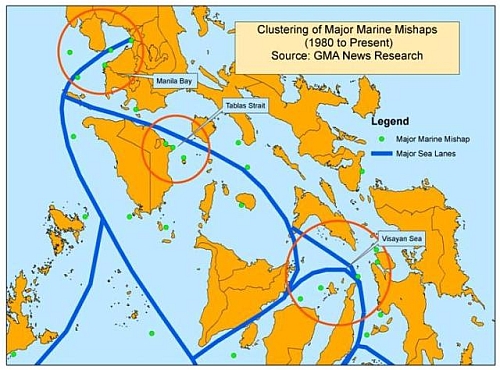Filtered by: Topstories
News
Senate sets Tuesday probe into recent sea tragedies
(Updated 12:40 a.m.) As survivors recounted horror tales about life jackets being nailed to frames and crew members nowhere to guide passengers in abandoning ship, the Senate scheduled on Tuesday an inquiry into the two year-end sea accidents that claimed the lives of at least nine people with 40 others still missing. Senator Richard Gordon, chairman of the Senate blue ribbon committee, said the sea accidents show that the government agencies, which are supposed to regulate and enforce laws on maritime safety, seem helpless from preventing such major disasters. “Since the record-setting MV Doña Paz tragedy, more deadly maritime disasters have happened including the sinking of MV Commando 6 last May where the three-year-old Franco Eugenio died; the MV Princess of the Stars where of the 850 on board only 57 survived; the sinking of the Super Ferry 9 last September even on a fair weather; and these two recent sea tragedies in Cavite and Batangas where at least 10 people died," Gordon said.  On December 24, motor banca M/V Catalyn-B, which had 15 crew members and 59 passengers, sank after its front collided with the back of the steel fishing vessel Anatalya, four nautical miles off Limbones Island in Cavite at 2:20 a.m. [See: 46 rescued, 27 still missing in Cavite predawn sea mishap] Search and rescue operations have so far yielded three bodies, while 24 are still missing. Authorities sighted at least 12 bodies, including two infants, found trapped inside the wreckage. [See: Bodies seen inside wreck of sunken boat in Cavite] Three days later, M/V Baleno 9, a roll-on, roll-off (RORO) vessel owned by Besta Shipping Lines carrying 88 passengers and crew members, sank off Verde Island in Batangas province. At least six were killed while almost two dozen others remained missing. [See: 6 dead, 20 missing as ferry sinks off island in Batangas] Life jackets nailed to frames In an interview over GMA News’s "24 Oras," a survivor of the Catalyn-B sinking said they found it difficult to secure a life jacket, as the string of its life ring was nailed to the frame. Recounting his own ordeal, another survivor disclosed that before the ship left the port, no briefing was made about where life jackets are located. Before the sinking, the survivor also said crew members were sleeping at the ship’s lower level and no buzzer was sounded to alarm the passengers of the accident. Meanwhile, survivors of the M/V Baleno 9 said they hear a loud thud from under the ship, which started tilting 10 minutes later and eventually capsized. PCG officials are now having a hard time searching for survivors and even finding the ship’s body, as it sank in the region of 500 to 700-feet-deep water, with divers only able to go as deep as 120 feet.
On December 24, motor banca M/V Catalyn-B, which had 15 crew members and 59 passengers, sank after its front collided with the back of the steel fishing vessel Anatalya, four nautical miles off Limbones Island in Cavite at 2:20 a.m. [See: 46 rescued, 27 still missing in Cavite predawn sea mishap] Search and rescue operations have so far yielded three bodies, while 24 are still missing. Authorities sighted at least 12 bodies, including two infants, found trapped inside the wreckage. [See: Bodies seen inside wreck of sunken boat in Cavite] Three days later, M/V Baleno 9, a roll-on, roll-off (RORO) vessel owned by Besta Shipping Lines carrying 88 passengers and crew members, sank off Verde Island in Batangas province. At least six were killed while almost two dozen others remained missing. [See: 6 dead, 20 missing as ferry sinks off island in Batangas] Life jackets nailed to frames In an interview over GMA News’s "24 Oras," a survivor of the Catalyn-B sinking said they found it difficult to secure a life jacket, as the string of its life ring was nailed to the frame. Recounting his own ordeal, another survivor disclosed that before the ship left the port, no briefing was made about where life jackets are located. Before the sinking, the survivor also said crew members were sleeping at the ship’s lower level and no buzzer was sounded to alarm the passengers of the accident. Meanwhile, survivors of the M/V Baleno 9 said they hear a loud thud from under the ship, which started tilting 10 minutes later and eventually capsized. PCG officials are now having a hard time searching for survivors and even finding the ship’s body, as it sank in the region of 500 to 700-feet-deep water, with divers only able to go as deep as 120 feet.
For the latest Philippine news stories and videos, visit GMANews.TV Senate inquiry Through the inquiry, Gordon wanted to know the possible malfeasance, misfeasance and nonfeasance of the Philippine Coast Guard (PCG), the Department of Transportation and Communications (DOTC), the Maritime Industry Authority (Marina) and other concerned government agencies, which resulted in the wanton disregard of safety rules and regulations by ferry operators causing avoidable sea tragedies and loss of lives. “Our country holds the unflattering distinction for having the world’s worst peacetime maritime safety record. We are an archipelagic country, and so we must have better standards of shipping, we have to modernize our maritime fleet," he said. He noted that a review of Philippine performance on maritime safety reveals a long history of allegations of gross negligence and collusion between ferry operators and government agencies resulting in maritime disasters and loss of lives. Aside from finding out who are accountable for such tragedies, Gordon said, the Senate investigation is being conducted to be able to devise laws that would require, among others, the modernization of the country’s maritime fleet, better training of people in the maritime industry, and more stringent requirements for sea crafts sailing the Philippine waters. Philippine marine accidents in history In 2008, Marina recorded a total of 426 sea craft which figured in accidents, resulting in 835 persons dead and 643 missing. This year, 69 sea accidents have been recorded to date. The worst marine tragedy in recent Philippine history is the sinking of M/V Doña Paz in 1987, with the official death tool at 1,856 people, although news reports recorded as many as 4,000 killed. [See: Major marine mishaps in the Philippines ] A GMA News Research report in 2008 also showed that the three most accident-prone areas in Philippine seas are the Manila Bay, Tablas Strait, and Visayan Sea. [See: "Accident-prone" areas at sea identified] Also in 2008, a look at the PCG’s capacity to man the country’s 36,289-kilometer coastline showed that 40 percent of the agency’s 59 vessels and five aircraft are either “not ready for sea" or grounded, with communication among units still limited to texting via cellular phones. [See: Maritime safety not a priority in RP; Coast Guard struggles to stay afloat] – Amita O. Legaspi with report from Jerrie M. Abella/JV, GMANews.TV; map by Brenda C. Barrientos, GMA News Research
Also in 2008, a look at the PCG’s capacity to man the country’s 36,289-kilometer coastline showed that 40 percent of the agency’s 59 vessels and five aircraft are either “not ready for sea" or grounded, with communication among units still limited to texting via cellular phones. [See: Maritime safety not a priority in RP; Coast Guard struggles to stay afloat] – Amita O. Legaspi with report from Jerrie M. Abella/JV, GMANews.TV; map by Brenda C. Barrientos, GMA News Research

Survivors sit inside a van upon arrival Sunday, Dec. 27, 2009, in Batangas City after passenger ferry M/V Baleno 9 sank off Verde Island in a second sea disaster in three days. AP-Pat Roque
For the latest Philippine news stories and videos, visit GMANews.TV Senate inquiry Through the inquiry, Gordon wanted to know the possible malfeasance, misfeasance and nonfeasance of the Philippine Coast Guard (PCG), the Department of Transportation and Communications (DOTC), the Maritime Industry Authority (Marina) and other concerned government agencies, which resulted in the wanton disregard of safety rules and regulations by ferry operators causing avoidable sea tragedies and loss of lives. “Our country holds the unflattering distinction for having the world’s worst peacetime maritime safety record. We are an archipelagic country, and so we must have better standards of shipping, we have to modernize our maritime fleet," he said. He noted that a review of Philippine performance on maritime safety reveals a long history of allegations of gross negligence and collusion between ferry operators and government agencies resulting in maritime disasters and loss of lives. Aside from finding out who are accountable for such tragedies, Gordon said, the Senate investigation is being conducted to be able to devise laws that would require, among others, the modernization of the country’s maritime fleet, better training of people in the maritime industry, and more stringent requirements for sea crafts sailing the Philippine waters. Philippine marine accidents in history In 2008, Marina recorded a total of 426 sea craft which figured in accidents, resulting in 835 persons dead and 643 missing. This year, 69 sea accidents have been recorded to date. The worst marine tragedy in recent Philippine history is the sinking of M/V Doña Paz in 1987, with the official death tool at 1,856 people, although news reports recorded as many as 4,000 killed. [See: Major marine mishaps in the Philippines ] A GMA News Research report in 2008 also showed that the three most accident-prone areas in Philippine seas are the Manila Bay, Tablas Strait, and Visayan Sea. [See: "Accident-prone" areas at sea identified]
 Also in 2008, a look at the PCG’s capacity to man the country’s 36,289-kilometer coastline showed that 40 percent of the agency’s 59 vessels and five aircraft are either “not ready for sea" or grounded, with communication among units still limited to texting via cellular phones. [See: Maritime safety not a priority in RP; Coast Guard struggles to stay afloat] – Amita O. Legaspi with report from Jerrie M. Abella/JV, GMANews.TV; map by Brenda C. Barrientos, GMA News Research
Also in 2008, a look at the PCG’s capacity to man the country’s 36,289-kilometer coastline showed that 40 percent of the agency’s 59 vessels and five aircraft are either “not ready for sea" or grounded, with communication among units still limited to texting via cellular phones. [See: Maritime safety not a priority in RP; Coast Guard struggles to stay afloat] – Amita O. Legaspi with report from Jerrie M. Abella/JV, GMANews.TV; map by Brenda C. Barrientos, GMA News Research More Videos
Most Popular




